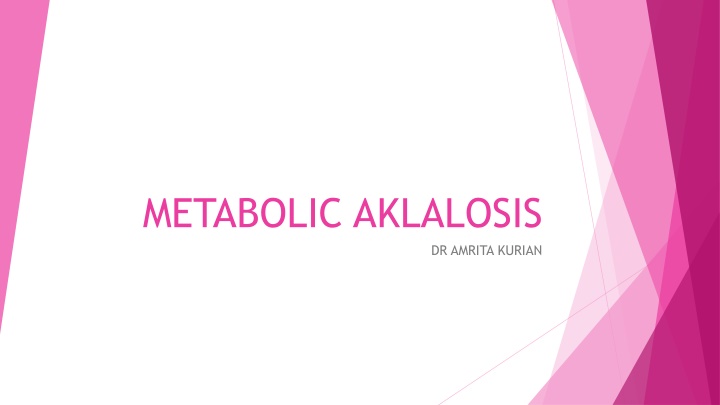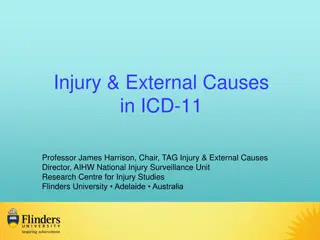
Metabolic Alkalosis: Causes and Mechanisms Explained
Metabolic alkalosis is characterized by elevated arterial pH, increased serum bicarbonate, and compensatory alveolar hypoventilation. Learn about the pathogenesis, maintenance factors, key epithelial transporters, mechanisms, and golden rules associated with metabolic alkalosis. Discover how to assess the extracellular fluid volume, serum potassium levels, and renin-aldosterone system to determine the cause of metabolic alkalosis.
Download Presentation

Please find below an Image/Link to download the presentation.
The content on the website is provided AS IS for your information and personal use only. It may not be sold, licensed, or shared on other websites without obtaining consent from the author. If you encounter any issues during the download, it is possible that the publisher has removed the file from their server.
You are allowed to download the files provided on this website for personal or commercial use, subject to the condition that they are used lawfully. All files are the property of their respective owners.
The content on the website is provided AS IS for your information and personal use only. It may not be sold, licensed, or shared on other websites without obtaining consent from the author.
E N D
Presentation Transcript
METABOLIC AKLALOSIS DR AMRITA KURIAN
Elevated arterial pH Increase in the serum bicarbonate Increase in PaCO2 as a result of compensatory alveolar hypoventilation. Often accompanied by hypochloremia and hypokalemia.
PATHOGENESIS Results from net gain of bicarbonate or loss of nonvolatile acid (usually HCl by vomiting) from the extracellular fluid. Generation stage : Loss of acid typically causes alkalosis When vomiting/NG suction causes loss of HCl from stomach, bicarbonate secretion can t be initiated in the small bowel bicarbonate is added to the ECF. Maintenance stage: secondary factors prevent the kidneys from compensating by excreting HCO3 Maintenance of metabolic alkalosis, therefore, represents a failure of the kidneys to eliminate excess HCO3 from the extracellular compartment.
Alkalosis will be maintained if (1) volume deficiency, chloride deficiency, and K+ deficiency exist in combination with a reduced GFR; or (2) hypokalemia exists because of autonomous hyperaldosteronism.
THE KEY EPITHELIAL TRANSPORTERS AND CHANNELS THAT PARTICIPATE IN HCO3 REABSORPTION AND SECRETION.
MECHANISMS ECF VOLUME CONTRACTION: results in hypotension and secondary hyperaldosteronism. PRIMARY HYPERALDOSTERONISM: ECF volume expansion + hypertension
3 GOLDEN RULES Metabolic alkalosis predominantly due to volume contraction as in vomiting, RTA, diuretics : SALINE RESPONSIVE, URINARY CHLORIDE <20mEq Metabolic Alkalosis with coexisting hypertension as in primary hyperaldosteronism, Cushing s Syndrome and Renin secreting tumors: SALINE UNRESPONSIVE, URINARY CHLORIDE > 20mEq Metabolic alkalosis persisting due to irreversible genetic defect of renal tubules as in Bartter s , Gitelman s or Liddle s syndromes: SALINE UNRESPONSIVE
Thus, to establish the cause of metabolic alkalosis we need to assess the status of the extracellular fluid volume (ECFV), the serum [K+], and in some circumstances, an assessment of the renin-aldosterone system. Eg (1) The presence of chronic hypertension and chronic hypokalemia in an alkalotic patient mineralocorticoid excess or that the hypertensive patient is receiving diuretics. Eg (2) Low plasma renin activity and normal values for both the urine [Na+] and [Cl ], in a patient who is not taking diuretics, suggests primary mineralocorticoid excess.
Eg (3) The combination of hypokalemia and alkalosis in a normotensive, nonedematous patient can be due to Bartter s or Gitelman s syndrome, magnesium deficiency, vomiting, exogenous alkali, or diuretic ingestion.
ALKALI ADMINISTRATION Chronic administration of alkali to those with normal renal function rarely causes alkalosis. In patients with coexistent hemodynamic disturbances associated with effective ECF volume depletion, alkalosis can develop because the normal capacity to excrete HCO3 is diminished or there may be enhanced reabsorption of HCO3. These include those who receive NaHCO3 (PO or IV), citrate loads (transfusions of whole blood or therapeutic apheresis), or antacids plus cation-exchange resins (aluminum hydroxide and sodium polystyrene sulfonate).
METABOLIC ALKALOSIS ASSOCIATED WITH ECFV CONTRACTION, K+ DEPLETION, AND SECONDARY HYPERRENINEMIC HYPERALDOSTERONISM GASTROINTESTINAL ORIGIN Gastrointestinal loss of H+ from vomiting or gastric aspiration causes simultaneous addition of HCO3 into the extracellular fluid. During active vomiting, the filtered load of bicarbonate reaching the kidneys is acutely increased and exceeds the reabsorptive capacity of the proximal tubule for HCO3 absorption. Subsequently, enhanced delivery of HCO3 to the distal nephron excretion of alkaline urine.
When vomiting ceases, the persistence of volume, potassium, and chloride depletion triggers maintenance of the alkalosis because these conditions promote HCO3 reabsorption (Maintenance stage) Correction of the contracted ECFV with NaCl and repair of K+ deficits with KCl corrects the acid-base disorder by restoring the ability of the kidney to excrete the excess bicarbonate.
RENAL ORIGIN DIURETICS Diuretics such as thiazides and loop diuretics increase excretion of salt and acutely diminish the ECFV without altering the total body bicarbonate content. The serum [HCO3 ] increases because the reduced ECFV contracts around the [HCO3 ] in the plasma (contraction alkalosis). The chronic administration of diuretics increase distal salt delivery, so that both K+ and H+ secretion are stimulated.
The alkalosis is maintained by persistence of the contraction of the ECFV, secondary hyperaldosteronism, K+ deficiency, and the direct effect of the diuretic (as long as diuretic administration continues). Discontinuing the diuretic and providing isotonic saline to correct the ECFV deficit will repair the alkalosis.
SOLUTE LOSING DISORDERS : BARTTER S SYNDROME. Autosomal Recessive Mutations impeding Cl associated Na+ reabsorption in the TAL (through Na+/K+/2Cl cotransporter) Results in ECF volume contraction and stimulation of RAAS : loss of H+ and K+ Ill early in life with metabolic alkalosis & volume depletion(as in abusing loop diuretic agents). Hypercalciuria and mild hypomagnesemia
GITELMANS SYNDROME Genetic mutations inactivate thiazide sensitive Na+/Cl cotransporter in the early DCT Hypokalemia and metabolic alkalosis Clinically apparent later in life Hypomagnesemia & hypocalciuria
NONREABSORBABLE ANIONS AND MAGNESIUM DEFICIENCY Administration of large quantities of the penicillin derivatives (carbenicillin or ticarcillin) cause their nonreabsorbable anions to appear in the urine. Increases the transepithelial potential difference in the collecting tubule - enhances H+ and K+ secretion. Mg2+ deficiency may occur with chronic administration of thiazides, alcoholism,malnutrition and in Gitelman s syndrome. Potentiates the development of hypokalemic alkalosis by enhancing distal acidification through stimulation of renin and hence aldosterone secretion.
POTASSIUM DEPLETION: Chronic K+ depletion may cause metabolic alkalosis by increasing urinary acid (H+) excretion. The renal generation of NH4+ (ammoniagenesis) is upregulated directly by hypokalemia. Chronic K+ deficiency also upregulates the renal H+/K+ ATPase to increase K+ absorption at the expense of enhanced H+ secretion. Alkalosis associated with severe K+ depletion is resistant to salt administration, but repair of the K+ deficiency corrects the alkalosis.
AFTER TREATMENT OF LACTIC ACIDOSIS OR KETOACIDOSIS When an underlying stimulus for the generation of lactic acid or ketoacid is corrected by treatment of the underlying disorder, such as correction of shock or severe volume depletion by volume restoration, or with insulin therapy, respectively, the lactate or ketones are metabolized to yield an equivalent amount of HCO3 Acidosis-induced contraction of the ECFV and K+ deficiency act in concert to sustain the alkalosis.
POSTHYPERCAPNIA Prolonged CO2 retention with chronic respiratory acidosis enhances renal HCO3 absorption and the generation of new HCO3 (increased net acid excretion). Metabolic alkalosis results from the effect of the persistently elevated [HCO3 ] when the elevated PaCO2 is abruptly returned toward normal.
METABOLIC ALKALOSIS ASSOCIATED WITH ECFV EXPANSION, HYPERTENSION, AND HYPERALDOSTERONISM Increased aldosterone levels may be the result of (1) autonomous primary adrenal overproduction or (2) secondary aldosterone release due to renal overproduction of renin. Mineralocorticoid excess increases net acid excretion resulting in metabolic alkalosis, which is typically exacerbated by associated K+ deficiency. Salt retention is due to upregulation of the epithelial Na+ channels in the collecting tubule to aldosterone As a result of the associated ECFV expansion : hypertension
The kaliuresis persists because of mineralocorticoid excess and distal Na+ absorption causing enhanced K+ excretion continued K+ depletion with polydipsia, inability to concentrate the urine, and polyuria.
Liddles syndrome Autosomal Dominant. Inherited gain of function mutation of genes that regulate the collecting duct Na+ channel (ENaC). Liddle s is a rare monogenic form of hypertension due to volume expansion manifested as hypokalemic alkalosis with normal aldosterone levels.
TREATMENT Primarily directed at correcting the underlying stimulus for HCO3 generation. If primary aldosteronism or Cushing s syndrome is present, correction of the underlying cause, when successful, will reverse the hypokalemia and alkalosis. [H+] loss by the stomach or kidneys can be mitigated by the use of proton pump inhibitors or the discontinuation of diuretics. The second aspect of treatment is to remove the factors that sustain the inappropriate increase in HCO3 reabsorption, such as ECFV contraction or K+ deficiency.
Isotonic saline is recommended to reverse the alkalosis when ECFV contraction is present. If associated conditions preclude infusion of saline, renal HCO3 loss can be accelerated by administration of acetazolamide, a carbonic anhydrase inhibitor (125 250 mg IV), which is usually effective in patients with adequate renal function but can worsen K+ losses.






















